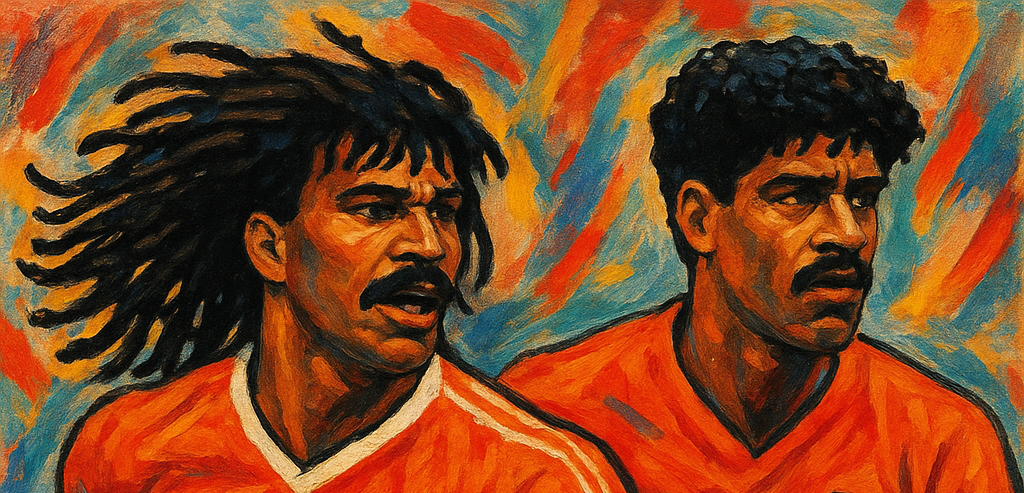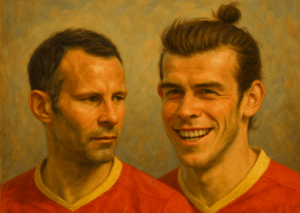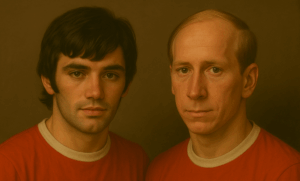
The GOAT of the Dutch Golden Era Midfielder?
In the late 1980s, the balance of power in European football was being redefined by a team in red and black stripes. This was Arrigo Sacchi’s AC Milan, and at its heart were three giants from the Netherlands: the ‘Oranje Trio.’ While Marco van Basten finished the chances up front, behind him were two of the most iconic midfielders in football history: Ruud Gullit and Frank Rijkaard.
They achieved perfect harmony in the same team, yet their methods of expressing footballing ideals were starkly different. If Gullit was the symbol of visible flair and explosive dynamism, Rijkaard was the quiet, intelligent anchor—the tactical brain that made the system work flawlessly. From the perspective of 2025, we will delve into a deep analysis of the careers and legacies of these two legends to explore the essence of their unique yet complementary greatness.
1. Two Personas: The Black Tulip vs. The Quiet Maestro
Ruud Gullit: ‘The Black Tulip,’ Incarnation of Total Football
Ruud Gullit was more than just a footballer; he was a cultural icon. Like his nickname, the ‘Black Tulip,’ his iconic dreadlocks and his powerful yet elegant style of play that dominated the pitch made him the symbol of ‘sexy football.’
His play was the living embodiment of the ‘Total Football’ philosophy—a complete, all-around player not bound by any single position.
- When he won the Ballon d’Or in 1987, he left a deep impression on the world by dedicating the honor to a then-imprisoned Nelson Mandela. This act proved he was not just a sports star but a global icon with a social conscience.
Frank Rijkaard: ‘The Quiet Maestro,’ The Tactical Anchor
While Gullit enjoyed the dazzling spotlight, Frank Rijkaard played the role of the team’s heart from the quiet shadows. His greatness was not as immediately apparent as Gullit’s, but it was the most fundamental element supporting the team’s structure.
- He was both a world-class defensive midfielder and a world-class center-back. His true value lay in his exceptional ability to read the game, his foresight to intercept threats before they materialized, and his capacity to instill a sense of stability in the team. He was the tactical anchor who provided the solid foundation that allowed a team’s attacking talents to showcase their skills without worry.
2. Playing Style and Versatility: The Perfect Coexistence
Gullit: Attacking Freedom and Overwhelming Physique
Gullit’s versatility shone brightest in the attacking third. His thunderous shots, explosive runs utilizing his long strides, and dominant aerial ability made him an unstoppable attacker. However, he was a complete ‘Total Footballer’ who also played as a Libero, orchestrating the game from the back of the defense early in his career, demonstrating world-class skill in defense, midfield, and attack.
Rijkaard: Tactical Intelligence and Stability
Rijkaard’s greatness stemmed from his tactical intelligence. He began his career as a center-back but, under the guidance of Arrigo Sacchi, became one of the world’s best defensive midfielders. His intelligent positioning and steady ball distribution laid the groundwork for the entire team to move organically. Crucially, attacking players like Gullit could roam the pitch freely because of the steadfast tactical support that Rijkaard provided.
The relationship between these two players transcended that of mere teammates. If Gullit was an unpredictable element like ‘fire,’ Rijkaard was the ‘ice’ that stabilized everything. Gullit’s explosive talent could only be fully realized without upsetting the team’s balance because it was built upon the platform of Rijkaard’s tactical stability.
3. A Career in Numbers: Records and Moments of Glory
Club Career Statistics
| Player | Clubs | Appearances | Goals | Assists |
|---|---|---|---|---|
| Ruud Gullit | HFC Haarlem, Feyenoord, PSV, AC Milan, Sampdoria, Chelsea | 576 | 219 | 108 |
| Frank Rijkaard | Ajax, Sporting CP, Real Zaragoza, AC Milan | 549 | 97 | 58 |
Netherlands National Team Record
| Player | Appearances (Caps) | Goals |
|---|---|---|
| Ruud Gullit | 66 | 17 |
| Frank Rijkaard | 73 | 10 |
Major Trophy Comparison
| Trophy | Ruud Gullit | Frank Rijkaard |
|---|---|---|
| European Cup / Champions League | 2 (1989, 1990) | 3 (1989, 1990, 1995) |
| UEFA European Championship | 1 (1988) | 1 (1988) |
| Serie A | 3 | 2 |
| Eredivisie | 3 | 5 |
| Intercontinental Cup | 2 | 2 |
Major Individual Awards Comparison
| Individual Award | Ruud Gullit | Frank Rijkaard |
|---|---|---|
| Ballon d’Or | 1st (1987) | 3rd (1988), 3rd (1989) |
| World Soccer Player of the Year | 2 (1987, 1989) | – |
| Dutch Footballer of the Year | 2 (1984, 1986) | 2 (1985, 1987) |
4. Role at AC Milan: The Two Engines of the Sacchi Revolution
Arrigo Sacchi’s AC Milan showcased revolutionary football based on pressing and the exploitation of space. At the center of this revolution were two Dutch-made engines: Gullit and Rijkaard.
- Gullit: The Free Spirit of the Attack
In Sacchi’s 4-4-2 formation, he was the ‘free spirit’ who roamed the entire pitch. He was the element of unpredictability within a highly organized system. - Rijkaard: The Master of the Midfield
He was the tactical cornerstone of Sacchi’s system. In Sacchi’s football, which maintained a high defensive line, he played the ‘defensive pivot’ role and was the key to balancing the team’s offense and defense.
5. Legacy Beyond the Pitch
Gullit: The Icon of Style and Symbolism
Gullit’s legacy lies in his symbolism as a cultural icon who represented an era. He built the image of the ‘perfect footballer’ where power and elegance coexisted, and his dedication of the Ballon d’Or to Nelson Mandela cemented him as a social figure beyond sports. His managerial career was not as illustrious as his playing days.
Rijkaard: The Manager Who Laid the Foundation for Barcelona
As a manager, Rijkaard had a profound impact on football history.
While many remember Pep Guardiola as the creator of modern Barcelona’s football, it was Rijkaard who laid the groundwork. He took over a stagnant Barcelona in 2003 and revived the 4-3-3 formation and possession-based football rooted in Johan Cruyff’s philosophy.
Not only did he win the Champions League in 2006, but he also provided crucial growth opportunities for young players like Lionel Messi, Xavi, and Iniesta by giving them key roles.
Conclusion: A Reflection on Contrasting Greatness
The answer to the question ‘Who was greater?’ inevitably depends on what one values.
Gullit was a player who dominated his era with visible talent and explosive play. His greatness lay in his overwhelming individual ability to change the flow of a game in an instant.
On the other hand, Rijkaard’s greatness was more fundamental and structural. He was a master of tactical intelligence who made the team, as an organism, function smoothly. His sacrifice and stability acted as a catalyst that maximized the talents of his teammates.
The most important fact is that their true greatness was only completed when they met each other. When Gullit’s explosive ‘fire’ and Rijkaard’s stable ‘ice’ combined, AC Milan and the Dutch national team became one of the most perfectly balanced teams in history. Their partnership was a perfect synergy created by contrasting forms of greatness and one of the most beautiful pictures the team sport of football can paint.




